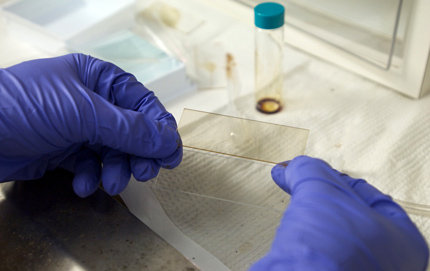Liquid Solar Cells that Can be Painted onto Surfaces
New research out of the University of Southern California (USC) advances the development of “cheap, stable solar cells made from nanocrystals so small they can exist as a liquid ink and be painted or printed onto clear surfaces.” This is exciting stuff.

The solar nanocrystals are about four nanometers in size – meaning one could fit more than 250 billion on the head of a pin – and float them in a liquid solution, so “like you print a newspaper, you can print solar cells,” said Richard L. Brutchey, assistant professor of chemistry in USC Dornsife.
Brutchey and USC postdoctoral researcher David H. Webber developed a new surface coating for the nanocrystals, which are made of the semiconductor cadmium selenide. Their research is featured as a “hot article” in Dalton Transactions, an international journal for inorganic chemistry.
Liquid nanocrystal solar cells are cheaper to fabricate than available single-crystal silicon wafer solar cells but are not nearly as efficient at converting sunlight to electricity. Brutchey and Webber solved one of the key problems of liquid solar cells: how to create a stable liquid that also conducts electricity.
In the past, organic ligand molecules were attached to the nanocrystals to keep them stable and to prevent them from sticking together. These molecules also insulated the crystals, making the whole thing terrible at conducting electricity.
“That has been a real challenge in this field,” Brutchey said.
Brutchey and Webber discovered a synthetic ligand that not only works well at stabilizing nanocrystals but actually builds tiny bridges connecting the nanocrystals to help transmit current.
With a relatively low-temperature process, the researchers’ method also allows for the possibility that solar cells can be printed onto plastic instead of glass without any issues with melting, resulting in a flexible solar panel that can be shaped to fit anywhere.
As they continue their research, Brutchey said he plans to work on nanocrystals built from materials other than cadmium, which is restricted in commercial applications due to toxicity.
“While the commercialization of this technology is still years away, we see a clear path forward toward integrating this into the next generation of solar cell technologies,” Brutchey said.

The solar nanocrystals are about four nanometers in size – meaning one could fit more than 250 billion on the head of a pin – and float them in a liquid solution, so “like you print a newspaper, you can print solar cells,” said Richard L. Brutchey, assistant professor of chemistry in USC Dornsife.
Brutchey and USC postdoctoral researcher David H. Webber developed a new surface coating for the nanocrystals, which are made of the semiconductor cadmium selenide. Their research is featured as a “hot article” in Dalton Transactions, an international journal for inorganic chemistry.
Liquid nanocrystal solar cells are cheaper to fabricate than available single-crystal silicon wafer solar cells but are not nearly as efficient at converting sunlight to electricity. Brutchey and Webber solved one of the key problems of liquid solar cells: how to create a stable liquid that also conducts electricity.
In the past, organic ligand molecules were attached to the nanocrystals to keep them stable and to prevent them from sticking together. These molecules also insulated the crystals, making the whole thing terrible at conducting electricity.
“That has been a real challenge in this field,” Brutchey said.
Brutchey and Webber discovered a synthetic ligand that not only works well at stabilizing nanocrystals but actually builds tiny bridges connecting the nanocrystals to help transmit current.
With a relatively low-temperature process, the researchers’ method also allows for the possibility that solar cells can be printed onto plastic instead of glass without any issues with melting, resulting in a flexible solar panel that can be shaped to fit anywhere.
As they continue their research, Brutchey said he plans to work on nanocrystals built from materials other than cadmium, which is restricted in commercial applications due to toxicity.
“While the commercialization of this technology is still years away, we see a clear path forward toward integrating this into the next generation of solar cell technologies,” Brutchey said.
You can return to the main Market News page, or press the Back button on your browser.

